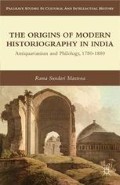Abstract
Warren Hastings’s policies in his early years as governor-general set an explicit intellectual agenda toward recovering original and “pure” Hindu social and political institutions from historical obscurity.1 This Hindu orientation, which was also taken up by the research agenda at the Asiatic Society of Bengal, characterizes much of early colonial engagement with Indian textual traditions. Colin Mackenzie felt the reverberations of this as he himself was quite close to the scholars and researches coming out of Calcutta at the Asiatic Society of Bengal. In fact, throughout his travels and collecting adventures, Mackenzie maintained frequent correspondence with the historian Mark Wilks and with Orientalists such as H. H. Wilson and Charles Wilkins. With Wilson and Wilkins, Mackenzie shared documents and texts in which he felt they would take particular interest. With Wilks, Mackenzie shared his ideas of history, the chaos of the historical record in India, and the need to collect historical materials for the Hindu history of the subcontinent. There was a discernable bias toward Hindu history as Mackenzie relied on Brahmins to provide texts on the political and religious history of south India. During the mid-nineteenth century, when C. P. Brown examined the contents of the Mackenzie archive, he immediately recognized the prevalence and importance of Hindu accounts.
Access this chapter
Tax calculation will be finalised at checkout
Purchases are for personal use only
Preview
Unable to display preview. Download preview PDF.
Notes
Michael Dodson, Orientalism, Empire, and National Culture: India, 1770–1880 (New York: Palgrave Macmillan, 2007), 22.
Charles Philip Brown, ed., “Preface,” in Memoirs of Hyder and Tippoo, Rulers of Seringapatam. Written in the Mahratta Language by Ram Chandra Rao ‘Punganuri,’ trans. Charles Philip Brown (Madras: Simkins and Co., 1849).
See Velcheru Narayana Rao, David Shulman, and Sanjay Subrahmanyam, Textures of Time: Writing History in South India 1600–1800 (Delhi: Permanent Black, 2001).
See Introduction by P.V. Parabrahma Sastry to Gramakaifiyatulu: Gunturu Taluka (Hyderabad: AP State Archives, 1984).
N. Venkataramanayya and M. Somasekhara Sarma, “The Kakatiyas of Warangal,” in The Early History of the Deccan, ed. by G. Yazdani (London: OUP, 1960) and
P. V. Parabrahma Sastry, The Kakatiyas of Warangal (Hyderabad: The Government of Andhra Pradesh, 1978), 193.
V. S. Pathak, Ancient Historians of India: A Study in Historical Biographies (New York: Asia Publishing House, 1966), 21. The emergence of historical narrative in the Sanskrit tradition has been compellingly analyzed by V.S. Pathak. He 21. See
Romila Thapar, “The Tradition of Historical Writing in Early India,” in Ancient Indian Social History (New Delhi: Orient Longman Limited, 1978), 271.
See Phillip B. Wagoner, Tidings of the King: A Translation and Ethnohistorical Analysis of the Rayavacakamu (Honolulu: University of Hawaii Press, 1993), cf 1, 171. For study of traditions of historical writing in South India, see
Velcheru Narayana Rao, David Shulman, Sanjay Subrahmanyam’s Symbols of Substance: Court and State in Nayaka Period Tamilnadu (New Delhi; New York: Oxford University Press, 1992.) and Textures of Time. Another important work on exploring the idea of ethnohistory is
Nicholas Dirks’s The Hollow Crown: Ethnohistory of an Indian Kingdom (Ann Arbor: University of Michigan, 1993b). The authors of Symbols of Substance and Textures of Time have engaged with a wide variety of literary genres to rethink the place of history in south Indian textual traditions. They draw attention to specific forms prevalent in seventeenth- and eighteenth-century southern India, such as the abhyu-dayamu (a Telugu literary genre that takes its subject as the day in the life of a king) and vamsavali to point to a kind of historical consciousness present in the genres. Dirks’s work (along with that of B. Cohn) provides another perspective by bringing in a discussion of ethnohistory as way of approaching historical narrative in Indian traditions.
Sarojini Regani, Nizam-British Relations 1724–1857 (Hyderabad: Booklovers Private Limited, 1963), p. 71. Regani uses several kaifiyats in her study, some of which have been published and some manuscripts from the Government Oriental Manuscript Library (GOML.)
Charles Phillip Brown, trans., The Wars of the Rajas, Being the History of Anantapuram. Madras: The Christian Knowledge Society’s Press, 1853. S. Krishnaswami Ayyangar included some passages pertaining to Krishnadevaraya of Vijayanagara fame in his Sources of Vijayanagar History (Madras: University of Madras, 1919), 178–81.
Gurzada V. Apparao, Kanyasulkam (Hyderabad: Visalandhra Publishing House, 1992). Preface to the 2nd ed.,1909.
Peter Schmitthenner, Telugu Resurgence: C. P. Brown and Cultural Consolidation in Nineteenth-Century South India (New Delhi: Manohar, 2001).
Cynthia Talbot, Precolonial India in Practice: Society, Region, and Identity in Medieval Andhra, (New York: Oxford University Press, 2001).
See Nicholas Dirks, Castes of Mind: Colonialism and the Making of Modern India (Princeton, IL: Princeton University Press, 2001) and “Colonial Histories and Native Informants: Biography of an Archive,” in Carol Breckenridge and Peter Van Der Veer, eds., Orientalism and the Postcolonial Predicament: Perspectives on South Asia (Philadelphia: University of Pennsylvania Press, 1993).
Thomas Trautmann, The Madras School of Orientalism: Producing Knowledge in Colonial South India (New Delhi: Oxford University Press, 2009).
See Phillip Wagoner’s “Precolonial Intellectuals and Production of Colonial Knowledge,” in Comparative Study of Society and History 45, no. 4 (Oct 2003). Also see Thomas Trautmann, Aryans in British India, (New Delhi: Vistaar Publications, 1997) and
Eugene Irschick, Dialogue and History: Constructing South India, 1795–1895, (Berkeley: University of California Press, 1994).
Copyright information
© 2012 Rama Sundari Mantena
About this chapter
Cite this chapter
Mantena, R.S. (2012). Colin Mackenzie’s Archival Project and the Telugu Historical Record. In: The Origins of Modern Historiography in India. Palgrave Studies in Cultural and Intellectual History. Palgrave Macmillan, New York. https://doi.org/10.1057/9781137011923_5
Download citation
DOI: https://doi.org/10.1057/9781137011923_5
Publisher Name: Palgrave Macmillan, New York
Print ISBN: 978-1-349-34378-2
Online ISBN: 978-1-137-01192-3
eBook Packages: Palgrave History CollectionHistory (R0)

